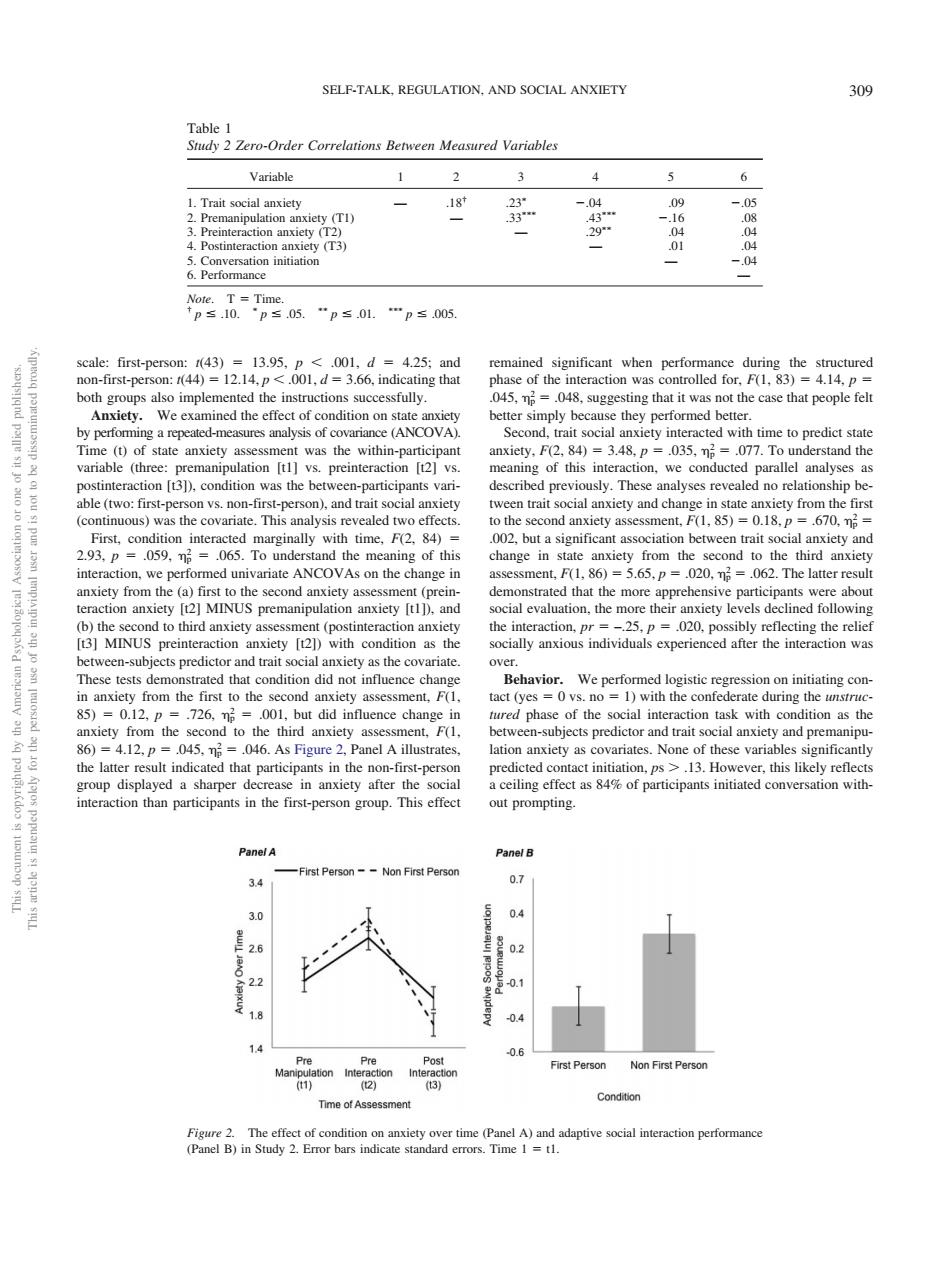正在加载图片...

SELF-TALK.REGULATION.AND SOCIAL ANXIETY 309 1 2 3 4 cial anxiety ety (T) sD5s.“ps01“pss 045..thatt wasnot the case that people felt repcated-n analysis of covariance (ANCOVA) stat was the within-parica 348.P=035 stand th coCspnomsoainNeson,ndtoclae en-participants var ndtion 02,butasiemificantasociaionbetweentrmits0cial interaction.w performed univariate ANCOVAs on the change in nent F(l 86)565n=020n 062 The latter resul t(postintcraction the in prein con 10n on wa These tests dem ated that condition did not inf Behavior. We performed log istic egression on initiating con m t 012 hase of the soci xiety from the F( 2 the third anxiety asses en-subjects predictor and trait and premanipu be latte sult indicated that particina s in the edicted co Ps>13.However.this likeh eroup displayed a eiling effect as84%of participants initiated conversation with- Panel日 First Person--Non First Persor 3.4 0.4 06 First Person Non First scale: first-person: t(43) 13.95, p .001, d 4.25; and non-first-person: t(44) 12.14, p .001, d 3.66, indicating that both groups also implemented the instructions successfully. Anxiety. We examined the effect of condition on state anxiety by performing a repeated-measures analysis of covariance (ANCOVA). Time (t) of state anxiety assessment was the within-participant variable (three: premanipulation [t1] vs. preinteraction [t2] vs. postinteraction [t3]), condition was the between-participants variable (two: first-person vs. non-first-person), and trait social anxiety (continuous) was the covariate. This analysis revealed two effects. First, condition interacted marginally with time, F(2, 84) 2.93, p .059, p 2 .065. To understand the meaning of this interaction, we performed univariate ANCOVAs on the change in anxiety from the (a) first to the second anxiety assessment (preinteraction anxiety [t2] MINUS premanipulation anxiety [t1]), and (b) the second to third anxiety assessment (postinteraction anxiety [t3] MINUS preinteraction anxiety [t2]) with condition as the between-subjects predictor and trait social anxiety as the covariate. These tests demonstrated that condition did not influence change in anxiety from the first to the second anxiety assessment, F(1, 85) 0.12, p .726, p 2 .001, but did influence change in anxiety from the second to the third anxiety assessment, F(1, 86) 4.12, p .045, p 2 .046. As Figure 2, Panel A illustrates, the latter result indicated that participants in the non-first-person group displayed a sharper decrease in anxiety after the social interaction than participants in the first-person group. This effect remained significant when performance during the structured phase of the interaction was controlled for, F(1, 83) 4.14, p .045, p 2 .048, suggesting that it was not the case that people felt better simply because they performed better. Second, trait social anxiety interacted with time to predict state anxiety, F(2, 84) 3.48, p .035, p 2 .077. To understand the meaning of this interaction, we conducted parallel analyses as described previously. These analyses revealed no relationship between trait social anxiety and change in state anxiety from the first to the second anxiety assessment, F(1, 85) 0.18, p .670, p 2 .002, but a significant association between trait social anxiety and change in state anxiety from the second to the third anxiety assessment, F(1, 86) 5.65, p .020, p 2 .062. The latter result demonstrated that the more apprehensive participants were about social evaluation, the more their anxiety levels declined following the interaction, pr –.25, p .020, possibly reflecting the relief socially anxious individuals experienced after the interaction was over. Behavior. We performed logistic regression on initiating contact (yes 0 vs. no 1) with the confederate during the unstructured phase of the social interaction task with condition as the between-subjects predictor and trait social anxiety and premanipulation anxiety as covariates. None of these variables significantly predicted contact initiation, ps .13. However, this likely reflects a ceiling effect as 84% of participants initiated conversation without prompting. Table 1 Study 2 Zero-Order Correlations Between Measured Variables Variable 1 2 3 4 5 6 1. Trait social anxiety — .18† .23 .04 .09 .05 2. Premanipulation anxiety (T1) — .33 .43 .16 .08 3. Preinteraction anxiety (T2) — .29 .04 .04 4. Postinteraction anxiety (T3) — .01 .04 5. Conversation initiation — .04 6. Performance — Note. T Time. † p .10. p .05. p .01. p .005. Figure 2. The effect of condition on anxiety over time (Panel A) and adaptive social interaction performance (Panel B) in Study 2. Error bars indicate standard errors. Time 1 t1. This document is copyrighted by the American Psychological Association or one of its allied publishers. This article is intended solely for the personal use of the individual user and is not to be disseminated broadly. SELF-TALK, REGULATION, AND SOCIAL ANXIETY 309